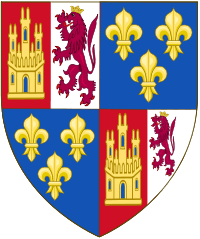Ferdinand de la Cerda
| Ferdinand de la Cerda | |
|---|---|
 Tomb of Ferdinand de la Cerda | |
| Spouse(s) | Blanche of France |
|
Issue | |
| Noble family | House de la Cerda |
| Father | Alfonso X of Castile |
| Mother | Violant of Aragon |
| Born | 23 October 1255 |
| Died |
1275 Ciudad Real |
Ferdinand de la Cerda (1255–1275) was the heir apparent to the Crown of Castile as the eldest son of Alfonso X and Violant of Aragon. His nickname, de la Cerda, means "of the bristle" in Spanish, a reference to being born with a full head of hair.[1]

Arm of the House de la Cerda to the 13th century, a combination of Castile and León, from infante Fernando, and the arms of France, for Blanche of France.[2]
In November 1268 he married Blanche, the daughter of King Louis IX of France. They had two sons:
- Alfonso de la Cerda (1270-1333), who was believed to have married Matilde of Narbonne, daughter of Viscount Aimery VI of Narbonne.[3] Recent research showed that Alfonso de la Cerda married Matilde of Brienne, daughter of John I of Brienne.[4] They had four sons and three daughters.
- Fernando de la Cerda (1275-1322), who married Juana Núñez de Lara, called "la Palomilla", Lady of Lara & Herrera, daughter of Juan Núñez de Lara “el Mayor” and Teresa Álvarez de Azagra. They had one son and three daughters. One daughter, Blanca Núñez de Lara, was the mother-in-law to King Henry II of Castile.
Ferdinand predeceased his father in 1275 at Ciudad Real from wounds received at the Battle of Écija. His sons did not inherit the throne of their grandfather, since their uncle Sancho usurped the throne.
Ancestry
| Ancestors of Ferdinand de la Cerda | ||||||||||||||||||||||||||||||||||||||||||||||||||||||||||||||||||||||||||||||||||||||||||||||||||||||||||||||||||||||||||||||||||||||||||||||||||||||||||||||||||||||||||||||||||||||||||||||||||||||||||||||||||||||||||||||||||||||||||||||||||||||||||||||||||||||||||||||||||||||||||||||||||||||||||||||||||||||||||||||||||||||||||||||||||||||||||||||||||||||||||||||||||||||||||||||||||||||||||||||||||||||||||||||||||||||||||||||||||||||||||||||||||||||||||||||||||||||||||||||||||||||||||||||||||||||||||||||||||
|---|---|---|---|---|---|---|---|---|---|---|---|---|---|---|---|---|---|---|---|---|---|---|---|---|---|---|---|---|---|---|---|---|---|---|---|---|---|---|---|---|---|---|---|---|---|---|---|---|---|---|---|---|---|---|---|---|---|---|---|---|---|---|---|---|---|---|---|---|---|---|---|---|---|---|---|---|---|---|---|---|---|---|---|---|---|---|---|---|---|---|---|---|---|---|---|---|---|---|---|---|---|---|---|---|---|---|---|---|---|---|---|---|---|---|---|---|---|---|---|---|---|---|---|---|---|---|---|---|---|---|---|---|---|---|---|---|---|---|---|---|---|---|---|---|---|---|---|---|---|---|---|---|---|---|---|---|---|---|---|---|---|---|---|---|---|---|---|---|---|---|---|---|---|---|---|---|---|---|---|---|---|---|---|---|---|---|---|---|---|---|---|---|---|---|---|---|---|---|---|---|---|---|---|---|---|---|---|---|---|---|---|---|---|---|---|---|---|---|---|---|---|---|---|---|---|---|---|---|---|---|---|---|---|---|---|---|---|---|---|---|---|---|---|---|---|---|---|---|---|---|---|---|---|---|---|---|---|---|---|---|---|---|---|---|---|---|---|---|---|---|---|---|---|---|---|---|---|---|---|---|---|---|---|---|---|---|---|---|---|---|---|---|---|---|---|---|---|---|---|---|---|---|---|---|---|---|---|---|---|---|---|---|---|---|---|---|---|---|---|---|---|---|---|---|---|---|---|---|---|---|---|---|---|---|---|---|---|---|---|---|---|---|---|---|---|---|---|---|---|---|---|---|---|---|---|---|---|---|---|---|---|---|---|---|---|---|---|---|---|---|---|---|---|---|---|---|---|---|---|---|---|---|---|---|---|---|---|---|---|---|---|---|---|---|---|---|---|---|---|---|---|---|---|---|---|---|---|---|---|---|---|---|---|---|---|---|---|---|---|---|---|---|---|---|---|---|---|---|---|---|---|---|---|---|---|---|---|---|---|---|---|---|---|---|---|---|---|---|---|---|---|---|---|---|---|---|---|---|---|---|---|---|---|---|---|---|---|---|---|---|---|---|---|---|---|---|---|---|---|---|---|---|---|---|---|---|---|---|---|---|---|---|---|---|---|---|---|---|---|---|---|---|---|---|---|---|---|---|---|---|---|---|---|---|
| ||||||||||||||||||||||||||||||||||||||||||||||||||||||||||||||||||||||||||||||||||||||||||||||||||||||||||||||||||||||||||||||||||||||||||||||||||||||||||||||||||||||||||||||||||||||||||||||||||||||||||||||||||||||||||||||||||||||||||||||||||||||||||||||||||||||||||||||||||||||||||||||||||||||||||||||||||||||||||||||||||||||||||||||||||||||||||||||||||||||||||||||||||||||||||||||||||||||||||||||||||||||||||||||||||||||||||||||||||||||||||||||||||||||||||||||||||||||||||||||||||||||||||||||||||||||||||||||||||
References
- ↑ Historia del apodo "de la Cerda". ARGOTE DE MOLINA, Gonzalo. Nobleza del Andaluzía. 1588.
- ↑ Maclagan, Michael and Jiri Louda, Lines of Succession, (MacDonald & Co., 1981), Table 47.
- ↑ Medieval Iberia: An Encyclopedia, Ed. E. Michael Gerli and Samuel G. Armistead, (Routledge, 2003), 50.
- ↑ Masnata y de Quesada, David E. (1985). «La Casa Real de la Cerda». Estudios Genealógicos y Heráldicos (Madrid: Asociación Española de Estudios Genealógicos y Heráldicos): pp. 169–229
- "Medieval Lands Project". Retrieved 2007-06-21.
This article is issued from Wikipedia - version of the 11/23/2016. The text is available under the Creative Commons Attribution/Share Alike but additional terms may apply for the media files.